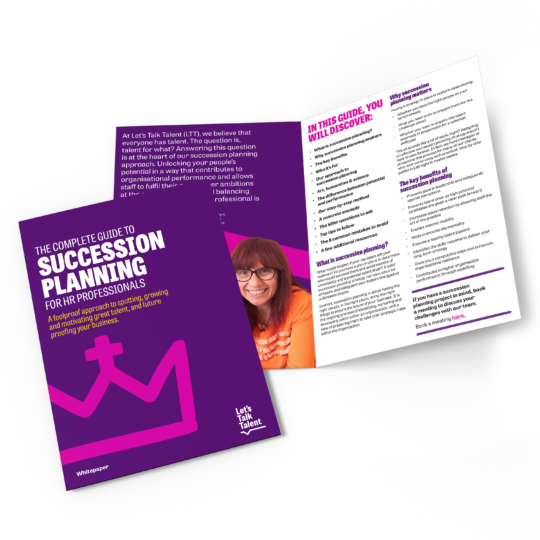Can an organisation realistically enable its employees to deliver on business objectives whilst also allowing them to reach their own goals and ambitions? At Let’s Talk Talent, we think so. And succession planning is a key tool in achieving this tricky balancing act.
Most organisations are already experiencing the fact that innovations such as the use of technology, automation, globalisation and new working patterns are changing the way customers interact with businesses at a nausea-inducing rate. Flexibility and a capacity to adapt to an ever-changing market have gone from being a useful competitive advantage in a company’s arsenal, to an absolutely essential survival tool. So how do organisations today ensure they not only remain afloat, but thrive in a choppy sea of change? Put simply, businesses need to have the right people in the right roles doing the right things in order to successfully deliver their objectives. But employees and their expectations are changing too and some may wonder if it is it even possible to perform on all fronts. We believe it is, and here is how.
What is Predictive Succession Planning?
Ensuring you have the right team in place to deliver on the company’s long-term strategy is a key step in futureproofing any business, and some employers have already drawn up succession plans to enable this. But succession planning isn’t just about spotting leadership skills, especially in the boardroom and for the C-suite. Organisations need to ensure the executive and the business as a whole mirror both its client base and internal talent pool. As such, looking for particular skills in future leaders isn’t enough and focus should be strongly placed on factors such as equality of representation, including gender balance, ethnicity and diversity, especially at high levels of the organisation.
This all looks easy enough on paper but, whilst working with clients, we have noticed a few stumbling blocks when the time came to operationalise this planning process and turn it into an actionable series of steps. This could be due to most managers still relying on traditional theoretical models, which offer a very linear view of succession planning. Want to understand who your future leaders are and give them the tools they will need to take on that challenge? This won’t happen by using a one-size-fits-all two-dimensional grid. We believe a much more hands-on approach is required to create the culture of empowerment your business needs to stand out in a competitive market. This is why, after years of collaborating with various organisations, we decided to think outside the box, add some colour to succession planning and develop our own model: Predictive Succession Planning.
Put simply, Predictive Succession Planning focuses on putting people at the core of everything you do, instead of trying to pin them somewhere on a ready-made map. It uses a mix of science, art and humanity to understand your business goals and identify high potential candidates to help them grow.
Breaking Down Predictive Succession Planning
But how do you even know who, amongst your talented many, are your high potential candidates? Traditional models mostly use current performance as a benchmark of leadership capabilities. We think differently. Whilst high performance is one of the factors to consider, it’s not the be-all and end-all. So how can you determine which candidates have the necessary learning agility to take on more complex challenges? The issue is that potential isn’t a measurable concept. Or we should say wasn’t. In order to make succession planning more tangible, we split potential into its smallest elements; the factors of potential. These are the traits and behaviours needed for any business to succeed: Courage, Insight, Drive, Curiosity and Impact. Clearly identifying the attributes future leaders need to possess can therefore allow organisations to spot employees displaying those factors of potential in their every-day professional life and take steps to help them reach the next level of their career.
But singling out the key employees that will deliver your long-term strategy is only the start of the process. Predictive Succession Planning aims to create the culture of open conversations and regular feedback needed to generate actions, spot development opportunities and mostly, facilitate honest discussions about the future. Being open and transparent about succession plans can be daunting, but it is an essential part of the implementation stage of any strategy. It does not require a separate channel or set of meetings either and can be easily integrated as part of a holistic approach to career development, aimed at everyone clearly understanding exactly how they can contribute to the future of the organisation.
Traditional succession planning has so far mostly been focussed on the business and ensuring the future of the organisation. Thus, it has its limitations. Predictive Succession planning goes further than that: it is about future-proofing your organisation, of course, but doing so whilst creating a culture of dynamic feedback and employee empowerment that will give you an edge and represent your customers accurately. It aims to go beyond theory to turn policies into immediately actionable plans that will ensure you have the right people in the right roles doing the right things. Because we believe everyone has potential. It’s just about figuring out what for and helping them get there. We are also excited to announce that we’ve just launched a predictive succession planning whitepaper.
If you’d like to know more about it, just get in touch, we’d be glad to provide you with additional information.
For your business to realise your ambitions, will depend on you identifying and developing your future leaders.
World class companies are obsessed by Predictive Succession Planning. Seeing it not just as a notion or a fad, but as an essential part of their talent strategy, giving it the energy it requires.
Download our Predictive Succession Planning Whitepaper now if you want to put in place robust processes to engage your future leaders.

